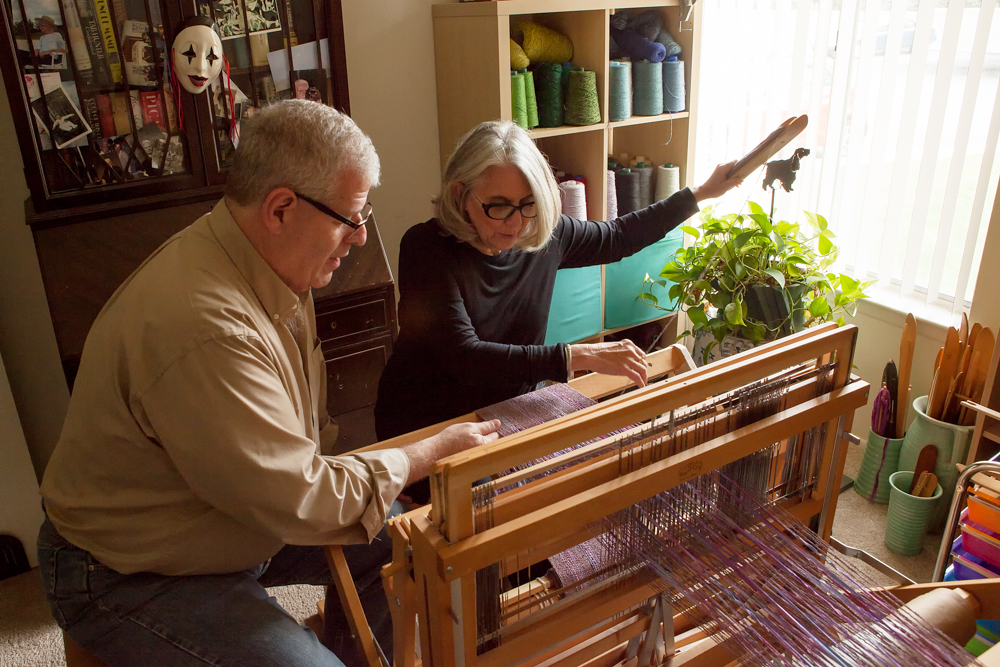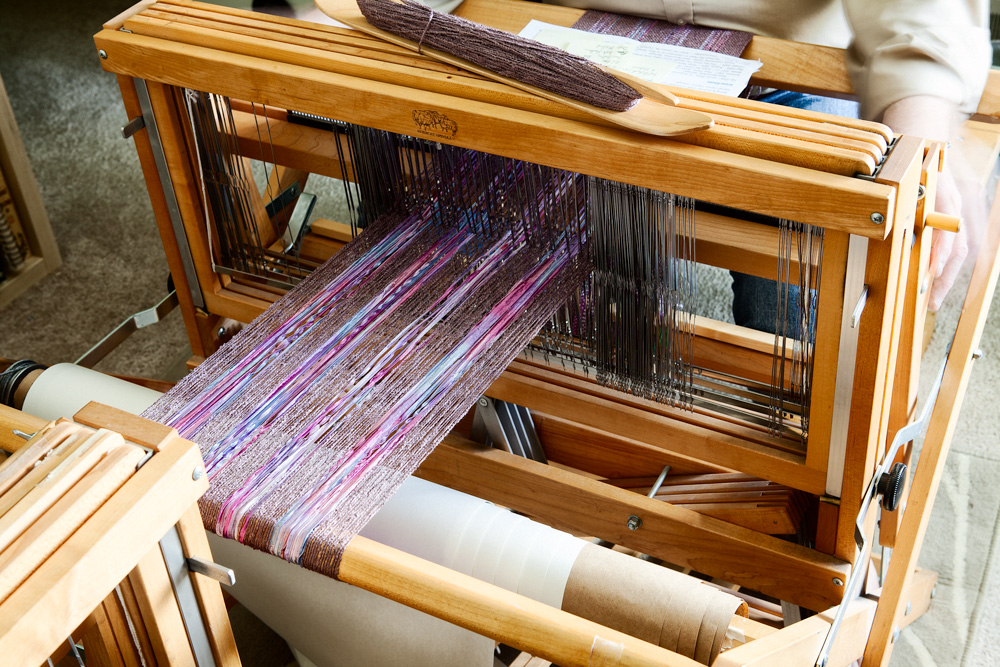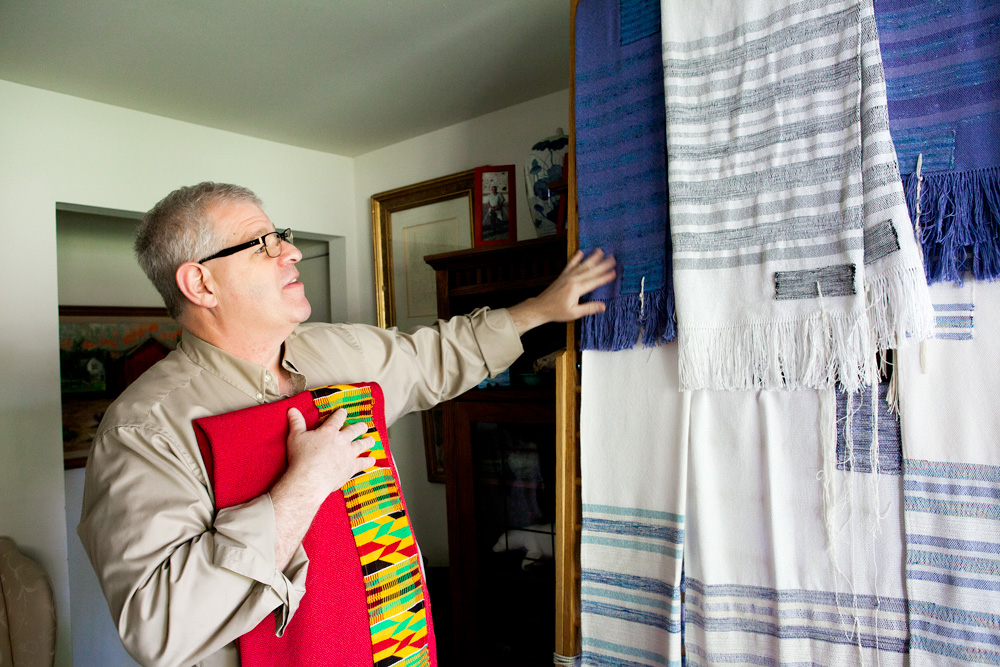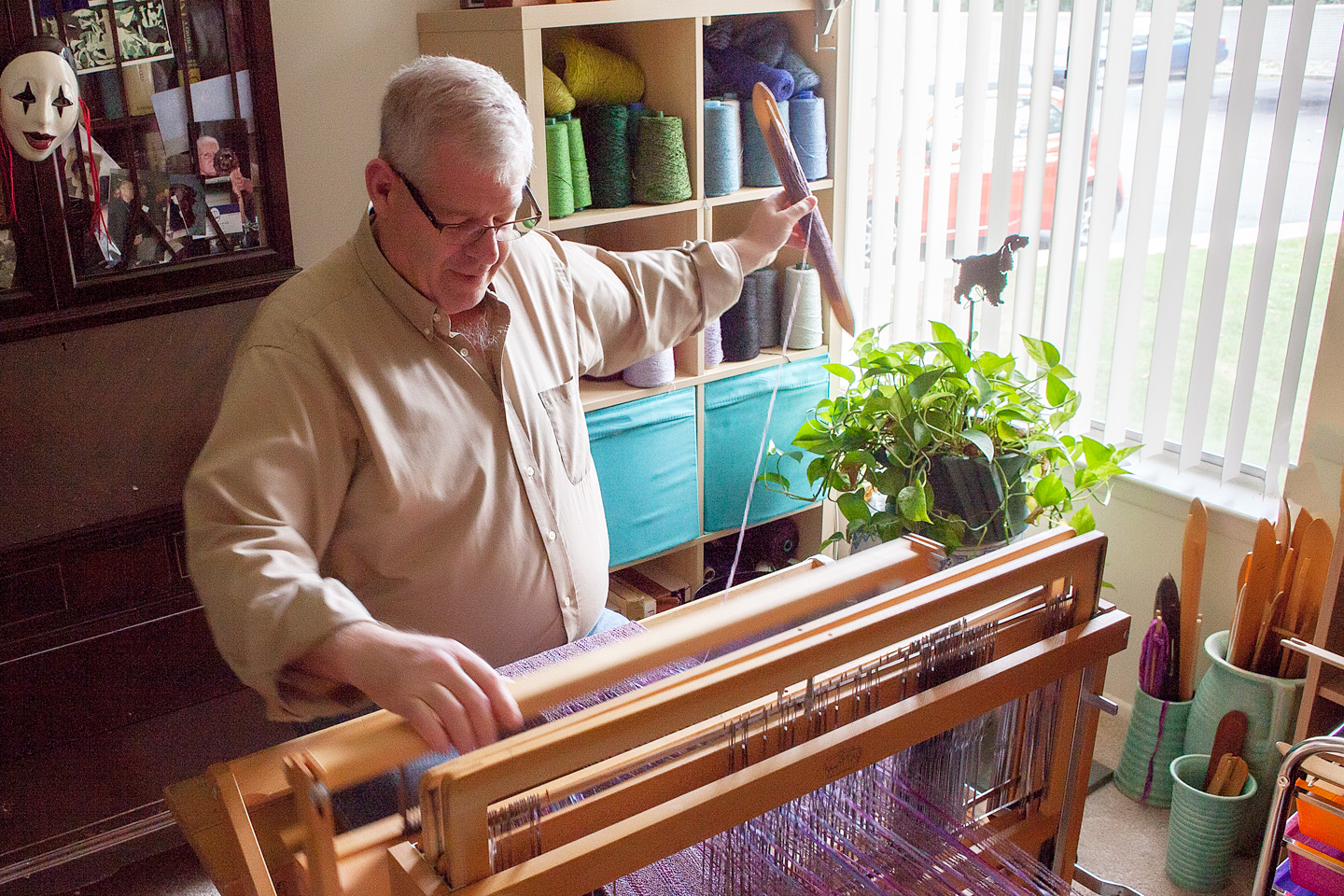Master Weaver: At Home on the Loom
By Vivian Henoch, Editor myJewishDetroit
September 30, 2015
Anyone can weave.
“Come, sit down at the loom and I’ll show you.”
And so begins a brief tutorial with Michael Daitch, master weaver, Judaic artist and educator.
“All weaving is even and odd – back and forth – like a conversation with a good friend,” he explains.
I study the intricate exchange of chenille yarn and silk ribbon threaded on one of the looms where Michael has taught nearly 400 b’nai mitzvah students of diverse abilities to weave their own tallits (prayer shawls), challah covers and other religious articles . . . wondering how.
With the encouragement, gentle humor and patience that I imagine Michael demonstrates with all of his students and their families, he starts with a story. “Once upon a time, ages ago, in every village and in every town, in every city in the world, there were weavers,” he instructs, “or people would all still be naked.”
Anyone can weave? Really? With bare feet on the treadles, I make my first furtive moves with the “shuttle” and the “beater,” searching for the rhyme, reason and rhythm of the “warp” and “weft” of the loom. “Don’t be intimidated, it’s all English,” Michael reassures.
An artist from the start, a weaver for 40 years
Born and raised in New York City, Michael first studied weaving at Eastern Michigan University, where he earned his Bachelor’s degree in Fine Arts. He attended the University of Michigan for graduate studies in Art History and, while living in Ann Arbor, bought his first loom. “I learned to weave on that thing, schlepped it to Columbus, Ohio, to work on my Masters at Ohio State University with Clara Creager, a famous weaver professor.”

Patiently, he watches my progress on the loom. “You feel the tension, you get the hang of it,” Michael tells me, “I’ve had students from five to 90 years old. I can teach anybody to weave.”
I believe him.
Whether speaking of the threads in the work at hand or the career path he’s woven through both the Jewish and greater Detroit communities, Michael has demonstrated his talents on many fronts. More than 17 years ago, he taught his life partner, Jim McCutchen (z’l), to weave. “Jim was retired and wanted to start a business with me. As it turned out, he took to weaving like a duck to water.” Together Michael and Jim established their studio, Coat of Many Colors Handweavers, and developed a large clientele through area galleries, juried art shows, lectures and weaving demos – all the while, Michael was deeply involved in community work as Business Manager for the Jewish Community Relations Council, a partner agency of Federation.
The Tallitot Project
Along with their studio work, Michael and Jim developed the Tallitot Project, a highly specialized method of teaching pre-Bat/Bar Mitzvah students (and their families) the art of tallit weaving.
“It all started around 2003, thanks to Harlene Appelman, former Chief Jewish Education Officer of Federation’s Alliance for Jewish Education (now Executive Director of the Covenant Foundation),” Michael explains. “Harlene was one of my best clients and a good friend — she loved wearing the scarves and shawls that I made. Out of the blue one morning, she calls me, ‘Please come to my office!’ Joking as usual, ‘Now what did I do?’ She goes, ‘Why don’t you do something with your weaving?’ ‘Like what,’ I said and she said, ‘Do something Judaic with kids!’ ‘You mean you want me to teach them to weave . . . tallits?’ And she goes, ‘Yeah! Great idea!’”
So I looked into it. As it happens, there are a lot of kosher rules to weaving related to mixing fibers and fabrics (called shatnes) and tying the traditional tzitzit (the little knotted braids on the four corners of the garment).
Luckily, working with Council, I knew most of the rabbis in town. So, I talked to Rabbi Michael Moskowitz and Rabbi Joseph Klein, who taught me how to tie the tzitzit. I soon became a tallit expert, then took another six months to experiment with a handful of families and close friends to perfect a foolproof method of teaching weaving that would yield beautiful results for any beginner working with my guidance over a session lasting approximately three hours.

Thanks to Harlene, we launched the Tallitot Project in 2004 with the first in a series of eight grants from Federation’s Artist in School Program, funded through the DeRoy Testamentary Foundation. Our very first project was a remarkable leap of faith, involving a b’nai mitzvah class of 20 students at Congregation Shir Tikvah, in Troy, working with Rabbis Arnie Sleutelberg and Aaron Starr. It was a Tzedakah Project of the tallest order. We enlisted the help of two volunteers – Micki Grossman and Edwina Davis — and brought three warp looms into class – each threaded with three tallits. We set the class to work on Sunday mornings over a period of two months. Our goal? To complete 20 tallits as b’nai mitzvah gifts to be donated anonymously to Jewish families in the former Soviet Union who were unable to afford prayer shawls for their children. Altogether, the finished tallits were exhibited in a spectacular display at the children’s museum, Shalom Street at the JCC, before they were sent off, courtesy of ORT, to their final destination.
“As a result of that first project, I now have a formula that virtually never goes wrong – no matter what the capabilities of the student. To start, I sit down at the loom with each student – including family members. I have dozens of samples and hundreds of yarns from which to choose. And together we decide on the style, as well as the decorative atarah (collar piece) and corners that I generally weave separately. Then we measure the parents – to approximate the correct size of the tallit so it fits properly as the child grows to adulthood. It’s a lovely process. And each one is a thrill for me, just to see a young person weave with amazing proficiency in such short order. And when you think about it, how many kids get to make their own tallits for their bar or bat mitzvah? And the finished pieces are just beautiful – keepsakes for life.”
Opening the Doors. . . Further
As Michael also learned in the first stages of the Tallitot Project, students with learning challenges responded particularly well to the tactile, kinesthetic learning style of his program. With that discovery, Ellen Maiseloff, Director of Federation’s Opening the Doors Program, stepped in to extend the reach of the program to students with special needs.
Ellen observes, “There’s so much more at work in Michael’s program than what meets the eye. His gentle and engaging teaching style makes perfect sense of the many different ways in which each child can best learn and succeed. Weaving a tallit is an experience each child can own – a personal achievement that helps strengthen their identity. That sense of empowerment shines through every moment of the bar mitzvah celebration for the entire family.”
Through Michael’s work, one family was especially moved to set up an endowment for students with special needs in the program at Temple Israel. “We serve about five b’nai mitzvah students a year through Opening the Doors,” says Michael, “and by my estimate, I’d say we’ve touched the lives of 35 to 40 families through this one program.”
Summers at Camp Ramah
Michael often describes himself as a weaver unlike any other, quite possible the only Judaic weaving teacher in the country. The job may be singular, but it’s far from lonely, as he receives a steady stream of calls and referrals. Again, it was Harlene who called him one day, this time with the prospect of working as artist-in-residence in a family camp for autistic children at Camp Ramah Darom’s Yofi in Clayton Georgia. “I asked Harlene what I was supposed to be doing, Michael recalls, “and she replied, ‘Your teaching style is in-touch with the kids and so well matched to the program, I’m sure you’ll think of something.’

So, we wove checkerboards for playing checkers — easy to weave, easy to tie up like hobo bags. It was a very cool and clever idea. And, of course, the kids loved it.”
“Michael’s weaving is a metaphor for his teaching and an incredible contribution to our community,” observes Harlene Appelman. “He has a rhythm, a generosity and empathy that rarely are found, but are key ingredients that always make for outstanding teaching.” – Harlene Winnick Appelman, Executive Director, Covenant Foundation
Weaving is a “personal thing” to Michael, his art is deeply woven into his Jewish identity. “I believe in the Jewish ethics of giving back to the community – as much as I can, and in any way that I can. And through weaving, I know I am making a difference.”
If you have yet to have the pleasure of meeting Michael Daitch and seeing his work, save the date: Sunday, January 3, 2016, and join him for a session on the loom in Rivera Court at the Detroit Institute of Arts. Or find him online at Coat of Many Colors Handweavers.




